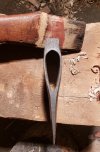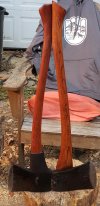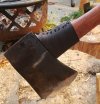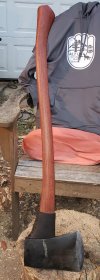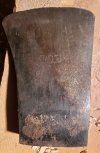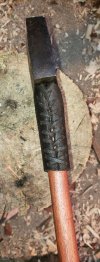I hope the members of this thread will forgive something a little off-topic, but I also think you might be the group to appreciate this.
Reading all of the posts here, seeing all the photos, and hearing all the stories I've gotten really excited about getting some old tools hung. And not just axes, either! I've seen other tools posted here, including some amazing looking hammers, that got me thinking about doing the same. You'll have seen, in a post I made yesterday, that I'm already in the process of hanging a couple of hammers.
A couple of weeks ago when I started thinking about hanging hammers I went into it with the intent of doing a few and picking out one or two that I was really happy with to replace my old Estwing. The whole idea of finding a great, vintage hammer head, and restoring it to use for myself was really exciting, and so I set out to do just that. To that end I started shopping old hammer heads on eBay and bought some new hickory handles from my local store. Subsequently I received some hammer heads in the mail and got to work.
In the course of doing this I had occasion to get out my old Estwing, needing to do some banging about with it, and decided to go ahead and clean it up a little. While I was doing that, sitting there, working on it, turning it over and over in my hands, I got to thinking about all the history I've got with this old hammer.
I can't recall at this point whether I received it as a gift from my parents or bought it myself, but I know that I got it when I was in early high school, about the time I was getting involved in my home town's summer theatre program. I chose Estwing because the one-piece design and the steel neck looked indestructible, and as a teenage boy I would need a tool as indestructible as myself. Over the next few years of high school that hammer sunk a lot of nails and helped me to build a lot of sets, and then it went off to college with me. In college it continued being applied to nails of all sorts, but it also found a new and valuable use. Properly tethered to my belt via a lanyard I would carry it up into scaffolds with me where I learned a trick of using it to pop the cross braces free single-handed (this involved hooking it under the drop-lock, lifting that piece up, and then popping the brace free with a twist of my wrist—otherwise a two-handed operation). With that additional use added to its repertoire it continued to hang at my side for years to come. After college, as I transitioned to a desk job, my hammer saw less and less use. Nonetheless it continued to be one of my most indestructible tools.
It really wasn't until I was on the verge of replacing my Estwing that I got to thinking about all the history I have with it. I've had this hammer for over 25 years, which is more than half of my life. Looking at it I can see a spot of light blue paint on the handle from working on a scaffold that had had spots repainted and not yet dry, and there's grey paint on the underside of the claw from the same use.
At this point I'll happily hang hammers if they come into my life, and I may even keep a few of them, but I won't ever again think in terms of replacing my old Estwing. You can't replace something which is a part of you.
I'm a little irritated about this, even though it isn't the worst damage it could have suffered.







